"Buddha, Mahabodhi Tree and the land of Nirvana"
Bodh Gaya Tourism
One of the most important pilgrimage sites for Buddhists, Bodhgaya is a village in the state of Bihar. It was here under the Bodhi tree that Gautama Buddha attained enlightenment. The place is bustling with pilgrims all through the year who come to pay their homage in the monasteries, shrines and temples. It also attracts tourists from India and abroad owing to its magnificent Buddha statue, the Mahabodhi Temple and the Bodhi tree.
Bodh Gaya is the very place that houses the Mahabodhi tree, under which Gautam Buddha meditated and attained enlightenment. TheMahabodhi templebuilt near the Mahabodhi tree is highly revered and it is an enriching experience to visit the temple. One can still find the remnants and descendants of the original Mahabodhi Tree. Bodh Gaya is the single biggest pilgrimage for all sects of Buddhists throughout the world. It is now one of the UNESCO World Heritage Sites and a lot of foreign countries including Japan and China have helped the Indian government in building facilities for the Buddhist pilgrims. Bodh Gaya also has other various temples and monasteries dedicated to Buddhism. Located near the river Neranjana, Bodh Gaya was earlier known as Uruwela. It was also known as Sambodhi, Vajrasana or Mahabodhi until the 18th century CE. A trip to Bodh Gaya provides valuable insights into the culture of Indian religious philosophies and also showcases some architectural masterpieces that would leave one spellbound.
Download Bodh Gaya PDF Guide >
What's Great?
Peaceful environment. Culturally and spiritually rich.
What's not so Great?
Extremely hot in summers. Not many non-vegetarian eateries available. Travelling at night might be risky.
For Whom
Bodh, commonly known as Bodhgaya, is one of the most sacred Buddhist pilgrimage centres in the world. Apart from pilgrims, Bodhgaya is a major attraction for historians, anthropologists and linguists.
The City of Enlightenment
Situated on the banks of river Neranjana, Bodh is a holy city in the state of Bihar. A UNESCO World Heritage Site today, Bodh was the place where Lord Buddha attained enlightenment and earned the name Bodhisattva. Thus, the small town is believed to be the most sacred place for Buddhists. Formerly known as Sambodhi, the city still holds evidence of Ashoka's contribution to commemorate Buddha's enlightenment and preach Buddhism. The small city holds several mysteries which leaves even historians mesmerised.
History of Bodh Gaya
Anciently known as Uruwela, Bodhgaya was situated on the banks of river Nerajana, now known as river Lilajan. King Ashoka is believed to have built the first temple on the land. As per theory, Buddha was born in 563 BC in a land which now belongs to Nepal, on the auspicious night of Baisakhi Purnima. Born as the son of a king, Prince Siddhartha renounced his world possessions at the age of 29 and travelled far and wide in search of the eternal truth.
After observing self-mortification for 6 years, he did not attain Vimukthi so he gave up the practice. He then discovered the Eightfold path which freed him from lust, hatred and delusion and thus attained enlightenment or ?Buddhatva?.
The tree under which he gained enlightenment is the renowned Bodhi tree. He gained numerous followers in the days to follow and the village turned into a pilgrimage centre. Emperor Ashoka himself was one of his biggest disciples and he built the famous Mahabodhi temple.
The sacred village gained momentum around the 13th century and plenty of shrines and temples were built. But soon after the area fell into the hands of the brutal Turkish emperors and they ransacked the city. The British rule later restored the city to its pure sacred form. At present, the city is one of the most important Buddhist pilgrim sites and is declared as world heritage site by UNESCO.
Itinerary
A visit to Bodhgaya is all about faith and religion. While the small town has got a lot of temples and places of worship, we have put down the few popular ones in the itinerary for you.
Day 1: You can start your trip by visiting the famous Thai Monastery followed by the world heritage site of Mahabodhi Temple, which is the root of an entire religion. Inside the temple is also located the holy shrine of Cankamana which have the imprints of Buddha?s footprints on stone lotus leaves. Post this, you can go witness the renowned Bodhi Tree under which Lord Buddha attained enlightenment. End the day by going to Vishnu Temple famed for having the footprints of Lord Vishnu.
Day 2: Begin the next day by going to Indosan Nippon Japanese Temple. Dedicate the next few hours to awe at the glorious magnificent statue of Buddha. There are plenty of guides available in the vicinity to answer your queries. Spend a quiet evening next to Muchalinda Lake.
In case, you are planning to stay another day and are in the mood for a rough trek, you can visit Dungeswari Hills. You can also choose from a number of temples to pay homage to- Chinese temple, Mangla Gauri temple, Sujatha temple etc.
Oct-Maris the best time to visit Bodh Gaya
October to March is ideal for a visit according to the weather conditions, but tourists flock here throughout the year. Post-October, a lot of monks, flock from Dharamshala to Bodh Gaya and the city is coloured with maroon robes. Dalai Lama himself spends some time here during December and January. Visitors also flock here in the month of Vaisakh (April-May) to celebrate the Buddha Purnima, the auspicious day when Siddhartha had attained enlightenment.
Weather in Bodh Gaya
Loading...
Bodh Gaya in Summer (March - June)
Summer temperature in Bodh ranges between 25 to 45 degrees Celcius. The hot and humid climate attracts fewer tourists during this season leading to drop in hotel prices.
Bodh Gaya in Monsoon (July - September)
Monsoons bring high rainfall in the region. Rains bring down the temperature of Bodh and make the weather comfortable for sightseeing.
Bodh Gaya in Winter (November - February)
Though winter mornings in Bodh are pleasant and ideal for sightseeing, the town receives chilly nights with dense fogs. Temperature ranges from 25 to 4 degrees Celcius during this season. The Kalachakra Festival is a major attraction in this season.
Monthly Weather in Bodh Gaya
Month
Avg. Minimum (°C)
Avg. Maximum (°C)
January
7
20
February
13
28
March
17
33
April
24
39
May
26
40
June
28
38
July
25
32
August
26
33
September
26
33
October
22
32
November
15
28
December
11
25
Comments on Bodh Gaya
Post Your Comment


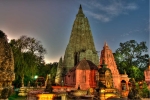 Mahabodhi Temple
Mahabodhi Temple Great Buddha Statue
Great Buddha Statue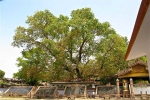 Bodhi Tree
Bodhi Tree Tibetan Refugee Market
Tibetan Refugee Market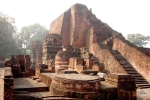 Nalanda
Nalanda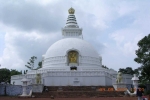 Rajgir
Rajgir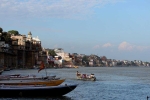 Varanasi
Varanasi Patna
Patna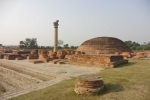 Vaishali
Vaishali Ranchi
Ranchi